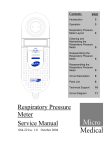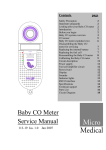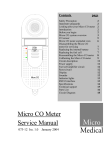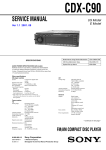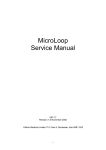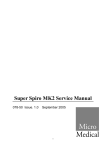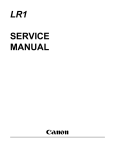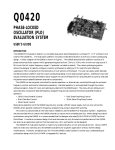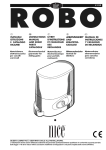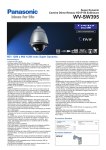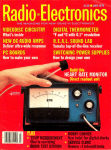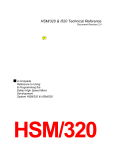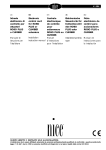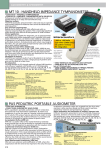Download MicroLoop - ServiceManual - Frank`s Hospital Workshop
Transcript
MicroLoop ServiceManual 047-11 Iss. 1.0 March 1998 Contents System Overview......................................................................................................... 3 Figure 1 ....................................................................................................................... 3 Transducer................................................................................................................... 4 Figure 2 ....................................................................................................................... 4 Disassembling the Microloop for Circuit Investigation ........................................... 5 Circuit Description Circuit Overview ............................................................................................................. 6 Processor Control Section ...................................................................................................................... 6 Address Bus............................................................................................................................................ 6 Ram Address Lines................................................................................................................................. 6 Reset....................................................................................................................................................... 6 Keypad .................................................................................................................................................... 6 Real Time Clock...................................................................................................................................... 7 Display..................................................................................................................................................... 7 Serial Interface........................................................................................................................................ 7 Battery Monitoring................................................................................................................................... 7 Power Supply.......................................................................................................................................... 7 Transducer Interface............................................................................................................................... 8 Parts List...................................................................................................................... 9 Technical Support ..................................................................................................... 11 Fault Analysis ............................................................................................................ 12 Circuit Diagram.......................................................................................................... 13 2 MicroLoop - System Overview (Fig. 1) The Micro Medical MicroLoop is a data recording spirometer consisting of a microcomputer unit (1) incorporating an LCD graphic display, data entry keypad, RS232 serial interface and all associated circuitry. This is supplied with a digital volume transducer (2), disposable mouthpieces, transducer holder (3) and mains adapter (4). The MicroLoop is powered by internal rechargeable Nickel Cadmium cells or by the mains adapter supplied (4). When testing a subject the transducer is inserted into the holder, which is plugged into the microcomputer unit. The digital volume transducer is used to measure the subjects expired flow and volume in accordance with the operating manual. 2 Micro Medical 1 3 MicroLoop 1 2 3 4 5 6 7 8 9 Del 0 5 4 Fig. 1 3 Transducer (Fig. 2) The Micro Medical digital volume transducer consists of an acrylic tube with a vane positioned between two swirl plates. The low inertia vane is attached to a stainless steel pivot, which is free to rotate on two jewelled bearings mounted at the centre of the swirl plates. As air is passed through the transducer a vortex is created by the swirl plates, which causes the vane to rotate in a direction dependant upon the direction of airflow. The number of rotations is proportional to the volume of air passed through the transducer and the frequency of rotation is proportional to the flow rate. The transducer housing consists of a main body, which contains a pair of light emitting diodes (LED’s) and phototransistors. The transducer is fixed to the mouthpiece holder, which pushes into the main body and is captured by an “O” ring seal. The LED’s produce infra red beams which are interrupted by the vane twice per revolution. This interruption is sensed by the phototransistors. The output from the collector of each phototransistor will be a square wave with a phase difference between the two of + or - 90 degrees depending upon the direction of flow. There is no routine maintenance required for the transducer other than cleaning according to the instructions in the operating manual. Micro Medical Digital Volume Transducer Rotating vane Infra red emitter Swirl plate Jewelled bearing Infra red detector Volume = k X No. of pulses Volume proportional to the number of pulses Flow proportional to the puse frequency Flow = k / pulse period 4 Disassembling the Microloop for Circuit Investigation 1. Disconnect all mains power supplies 2. Remove the rear adhesive label and disregard. We recommend that you use a Philip Number Zero screwdriver for the following instruction. 3. Place the Microloop face down to remove the two screws in the lower moulding, and put the screws to one side. 4. Turn the unit face up and ease the upper and lower mouldings apart by lifting the top moulding at an angle as illustrated in the diagram below until it becomes loose. 5. Ease the LCD display printed circuit board out of its plastic supports and rest inside of upper moulding. 6. Reconnect mains power supply 7. The Microloop is now ready for Circuit Investigation. If you are not familiar with the operation of the Microloop please read the following section in this manual ‘Circuit Description’ and use the Circuit diagrams at the back of this manual. Top moulding Locating lugs Battery pack Display 2 off screws Bottom moulding 5 Circuit Description Overview The microprocessor control circuit carries out the spirometry routines, monitors the transducer pulses and keypad, and drives the display under the control of the program stored in the battery backed RAM. The power supply uses the mains adapter, internal Nickel-Cadmium (Ni-Cad) cells and an internal lithium backup as its sources of energy. The supply provides 5 volts to the control circuit, -12 volts supply for the display and RS232 driver circuit, 3 volts RAM backup, controls the charging current to the Ni-Cad battery pack, and provides for battery management. The microprocessor (IC1) communicates with the real time clock (IC6), the output latch (IC5), and the display under the control of the program, stored in the RAM (IC2), using a multiplexed address and data bus decoded by a data latch (IC3). The RAM, which is used both for program storage and for temporary data storage, has a memory map which is partitioned by the action of the PAL (IC4) into writable and non-writable areas. Refer to Drawing ( 047-01 ) Address bus The microprocessor (IC1) uses a multiplexed address bus. The lower order address lines are latched into IC3 with the address strobe (AS). The program for the microprocessor (IC1) is stored in a 128kByte, battery backed static ram, (IC2). As the address space of the processor is limited to 64kBytes the ram address space is paged using a programmable array logic device (IC4). This device decodes address lines A1, A13, A14, A15, port lines PD5, PA4, c ontrol line R/W, clock signal E, mode control lines MODA, MODB, and the external reset line to provide the following outputs: RAM address lines A15 and A16 Chip select lines (CS) for the display and latch (IC5) Write enable (WR) for display, latch, and RAM Read enable (RD) for the display Output enable (OE) for the RAM Reset The reset circuit consists of a single chip reset (IC9) which holds the reset line (RES) low for 350ms after the 5 volt supply has reached the threshold voltage of 4.5 volts. The reset signal is applied to the microprocessor (IC1), display, programmable array logic device (IC4), and the printer driver processor (IC17). Keypad The 12 keypad switches ( 0 to 9, ENTER and DELETE) are arranged in a 3 column by 4 row matrix. When the keypad is being read by the processor the 3 columns are sequentially driven high by the output latch (IC5 pins 19,16 and 15). The state of the 4 rows is read by the general purpose port PE4 to PE7 of the processor. The diodes in the package D2 isolate the outputs from IC5 to ensure that a high current will not flow from an output set high to one set low if two keys are pressed simultaneously. The ON and OFF keys are connected to the power control circuitry described in the Power Supply section. 6 Real Time Clock The real time clock (IC6) is set by the processor during the factory set-up and should not require any further adjustment. The processor communicates with the real time clock (RTC) with a serial interface line to pin 5 of the RTC. The RTC is selected by the signal from pin 12 of the output latch (IC5). Display The display is a custom graphic 128 by 64 dot LCD with in-built control circuitry. The contrast is adjusted by varying the voltage on pin 3 between -4 and -12 volts with VR1. This potentiometer varies the output of the voltage inverter, IC12. Serial interface The microprocessor communicates with the integral printer and the external RS232 port using its serial communications interface. Serial information from the microprocessor is switched to either the printer driver or the external RS232 port under the control of the signal appearing on pin 9 of the latch (IC5). This signal controls the switching logic of IC10 and IC8. The serial output from the microprocessor, TXD, is applied to the input of IC10. Depending upon the state of the control signal, the serial information will either pass through IC10 to the printer controller (IC17) or through the level converter (TR4, and R22) to the external RS232 port. Battery monitoring The microprocessor contains eight, 8 bit analogue to digital converters. One of these, AN3 is used to monitor the condition of the main supply (BAT1). The main supply is monitored at the input to the logic 5-volt regulator (IC11) and the user will be alerted to a low battery condition when the voltage falls below 6 volts. The voltage is divided by two with R8 and R9 to bring the voltage within the range of the A/D converter (5 volts). AN3 also detects when the external power supply has been applied. One end of R10 is pulled to 0 volts when the external supply is not applied and the voltage read on the A/D converter will be up to 4 volts for a fully charged battery. With the external supply applied, the voltage will rise above 5 volts. Power Supply The power supply consists of linear 9 volt and 5 volt regulated supplies (IC7 and IC11), an adjustable switching regulator (IC12) and a lithium backup battery (BAT2), together with the NI-CAD charging circuit and low battery detector. The 9 volt regulator, IC7, is only operational when the mains adapter is connected and effectively replaces the 7.2 volt battery pack (BAT1) as the two supplies are connected through the dual diode D6. During this time the battery pack is trickle charged from the external supply by the 25mA constant current source formed by TR6, D1, R4, and R7. The bridge diode network, D4, provides protection against reverse polarity on the external supply. The inductors L1 and L2 provide attenuation of conducted noise to the external supply. The terminal voltage of the battery pack is monitored by an analogue input of the processor, AN3, through the potential divider network formed by R8 and R9. R8 is connected to the 9 volt supply, which is only active when the external supply is in use. The processor can detect when the external supply is in use as the analogue input will rise to above full scale, 5 volts, when this occurs. The input to the 5-volt regulator (IC11), and the voltage inverter (IC12), is controlled by TR5, which is turned on when the output of IC10 A is high. IC10 (gates A and B) form a bi-stable latch controlled by the ON and OFF switches on the keypad or by the microprocessor via TR1 and TR7. The processor turns on TR7 by taking port pin PA5 high when the unit turns off automatically either after a time out period or when the battery is low to conserve power. 7 Transducer interface The supply to the two series LED’s inside the transducer housing is provided through TR3. This is controlled by port pin PA3 of the processor and is only turned on during a spirometry manoeuvre to conserve power. However, power is supplied to the transducer through D5 continuously when the mains adapter is connected. Inside the transducer housing the two phototransistors used to detect the interrupted infra-red beam are in open collector configuration. The collectors are connected to pins 2 and 3 of SK2. The pull up resistor for the phototransistor connected to pin 2 is provided by R18 and R21 in parallel with a digital potentiometer (IC13). The pull up resistor for the other phototransistor is provided by R19 and R20 in parallel with digital potentiometer (IC14). Both digital potentiometers are factory set by the processor to give the largest possible signals on the collectors during a spirometry test and require no further adjustment. The processor writes to the control lines of the potentiometers (pins 1, 2, and 7) during this set-up via the output latch IC5.The signals from the phototransistors are applied to the pulse timing input of the processor (pin 32) and a general purpose port pin 33 after being squared up by the action of the schmitt inverters IC8 A and B. The rising edge of the signal applied to pin 32 causes an interrupt to be generated in the processor. This interrupt is processed by incrementing a pulse count, timing the period since the last pulse and by reading the state of pin 33. The pulse count is used to determine the volume passed through the transducer since the start of the test and the pulse period is used to determine the flow at each volume increment. The state of pin 33 at the time of the interrupt determines the direction of flow. 8 Parts List Designation IC1 IC2 IC3 IC4 IC5 IC6 IC7 IC8 IC9 IC10 IC11 IC12 IC15 R1 R2 R3 R4 R5 R6 R7 R8 R9 R10 R11 R12 R13 R14 R15 R16 R17 R18 R19 R20 R21 R22 R23 R24 R25 RN1 VR1 C1 C2 C3 C4 C5 C6 C7 C8 C9 C10 C11 Description (MC68HC11E1FN) MICROCONTROLLER (KM681000BLG/BLG-L) SAMSUNG 1 MEG SURFACE MOUNT STATIC RAM 55 TO 150nS ACCESS TIME (74HC573) SURFACE MOUNT OCTAL LATCH (PALCE16V8Z25PC) AMD ZERO POWER CMOS PLD DIP PACKAGE (74HC273) SURFACE MOUNT OCTAL D FLIP-FLOP (PCF8583T) PHILIPS SURFACE MOUNT CLOCK CALENDER WITH 256 BYTE RAM (LM2940T-9.0) LOW DROP OUT 9 VOLT 1 AMP REGULATOR (74HC14) SURFACE MOUNT HEX SCHMITT INVERTOR (DS1233D-10) DALLAS ECONO RESET (4093) SURFACE MOUNT QUAD NAND GATE (LM2931M-5.0) LOW DROP OUT 5 VOLT 100mA SURFACE MOUNT REGULATOR (LT1054CS8) SURFACE MOUNT VOLTAGE CONVERTOR (BU4S11) OR (BU4S01) RHOM INDIVIDUAL CMOS GATE 100K SURFACE MOUNT RESISTOR 0.125 WATT 5% SIZE 1206 1M SURFACE MOUNT RESISTOR 0.125 WATT 5% SIZE 1206 1K SURFACE MOUNT RESISTOR 0.125 WATT 5% SIZE 1206 27 OHMS SURFACE MOUNT RESISTOR 0.125 WATT 5% SIZE 1206 330 OHMS SURFACE MOUNT RESISTOR 0.125 WATT 5% SIZE 1206 1K SURFACE MOUNT RESISTOR 0.125 WATT 5% SIZE 1206 10K SURFACE MOUNT RESISTOR 0.125 WATT 5% SIZE 1206 100K SURFACE MOUNT RESISTOR 0.125 WATT 5% SIZE 1206 100K SURFACE MOUNT RESISTOR 0.125 WATT 5% SIZE 1206 100K SURFACE MOUNT RESISTOR 0.125 WATT 5% SIZE 1206 100K SURFACE MOUNT RESISTOR 0.125 WATT 5% SIZE 1206 100K SURFACE MOUNT RESISTOR 0.125 WATT 5% SIZE 1206 1K SURFACE MOUNT RESISTOR 0.125 WATT 5% SIZE 1206 33K SURFACE MOUNT RESISTOR 0.125 WATT 5% SIZE 1206 330K SURFACE MOUNT RESISTOR 0.125 WATT 5% SIZE 1206 10K SURFACE MOUNT RESISTOR 0.125 WATT 5% SIZE 1206 10K SURFACE MOUNT RESISTOR 0.125 WATT 5% SIZE 1206 4.7K SURFACE MOUNT RESISTOR 0.125 WATT 5% SIZE 1206 4.7K SURFACE MOUNT RESISTOR 0.125 WATT 5% SIZE 1206 3.3K SURFACE MOUNT RESISTOR 0.125 WATT 5% SIZE 1206 3.3K SURFACE MOUNT RESISTOR 0.125 WATT 5% SIZE 1206 3.9K SURFACE MOUNT RESISTOR 0.125 WATT 5% SIZE 1206 1K SURFACE MOUNT RESISTOR 0.125 WATT 5% SIZE 1206 100 OHMS SURFACE MOUNT RESISTOR 0.125 WATT 5% SIZE 1206 1M SURFACE MOUNT RESISTOR 0.125 WATT 5% SIZE 1206 4 WAY COMMONED 10K SIL NETWORK (T18 S/I S/B S/T 20KA) PHIER 20K LINEAR POTENTIOMETER RUBYCON 22uF 35 VOLT ELECTROLYTIC CAPACITOR TYPE 35MH522M0563 RUBYCON 47uF 16 VOLT ELECTROLYTIC CAPACITOR TYPE 16MH547M6357 RUBYCON 47uF 16 VOLT ELECTROLYTIC CAPACITOR TYPE 16MH547M6357 RUBYCON 47uF 16 VOLT ELECTROLYTIC CAPACITOR TYPE 16MH547M6357 RUBYCON 47uF 16 VOLT ELECTROLYTIC CAPACITOR TYPE 16MH547M6357 RUBYCON 47uF 16 VOLT ELECTROLYTIC CAPACITOR TYPE 16MH547M6357 RUBYCON 47uF 16 VOLT ELECTROLYTIC CAPACITOR TYPE 16MH547M6357 RUBYCON 47uF 16 VOLT ELECTROLYTIC CAPACITOR TYPE 16MH547M6357 10nF PHILIPS SURFACE MOUNT CERAMIC CAPACITOR SIZE 1206 15pF PHILIPS SURFACE MOUNT CERAMIC CAPACITOR SIZE 1206 10nF PHILIPS SURFACE MOUNT CERAMIC CAPACITOR SIZE 1206 9 C12 C13 C14 C15 C16 CD TR1 TR2 TR3 TR4 TR5 TR6 TR7 LED D1 D2 D3 D4 D5 D6 D7 D8 D9 L1 L2 DISPLAY SK1 SK2 SK3 SK4 SK5 SPKR X1 X2 BAT1 BAT2 10nF PHILIPS SURFACE MOUNT CERAMIC CAPACITOR SIZE 1206 33pF PHILIPS SURFACE MOUNT CERAMIC CAPACITOR SIZE 1206 33pF PHILIPS SURFACE MOUNT CERAMIC CAPACITOR SIZE 1206 1nF PHILIPS SURFACE MOUNT CERAMIC CAPACITOR SIZE 1206 1nF PHILIPS SURFACE MOUNT CERAMIC CAPACITOR SIZE 1206 100nF PHILIPS SURFACE MOUNT CERAMIC CAPACITOR SIZE 1206 (DTC114EK) RHOM NPN DIGITAL TRANSISTOR (DTC114EK) RHOM NPN DIGITAL TRANSISTOR (DTB113EK) RHOM PNP DIGITAL TRANSISTOR (DTA114EK) RHOM PNP DIGITAL TRANSISTOR (FMMT591) ZETEX PNP TRANSISTOR - SOT23 (2SB1189) RHOM PNP TRANSISTOR - MPT (SOT89) (DTC114EK) RHOM NPN DIGITAL TRANSISTOR T1/3mm ORANGE LED (IMN10) RHOM 3 DIODE ARRAY - IMD PACKAGE (IMN10) RHOM 3 DIODE ARRAY - IMD PACKAGE (IMN10) RHOM 3 DIODE ARRAY - IMD PACKAGE (S1NB20) SHINDENGEN 1A BRIDGE RECTIFIER (1SR154-400) RHOM 1A DIODE - PSM PACKAGE. ALTERNATIVE SHINDENGEN (D1F20) (S1ZAS4) SHINDENGN 1.2A DUAL SHOTTKY DIODE (S1ZAS4) SHINDENGN 1.2A DUAL SHOTTKY DIODE (BAS19) SMALL SIGNAL DIODE SOT23 PACKAGE (ZHCS750) ZETEX SMALL SIGNAL SHOTTKY DIODE SOT23 PACKAGE (NLC565050T-3R9K) TDK 3.9uH SURFACE MOUNT INDUCTOR (NLC565050T-3R9K) TDK 3.9uH SURFACE MOUNT INDUCTOR (DMF-50424N) OPTREX 128 X 64 GRAPHIC DISPLAY (MDS4) 4 WAY MINI DIN SOCKET (95001-2611) MOLEX 6 WAY DATA SOCKET 10 WAY PIN HEADER (MJ-179P) DC POWER SOCKET (B 3B-PH-SM3-TB) 3 WAY PCB SOCKET FROM JST (PKM35-4A0) MURATA PIEZO CERAMIC SOUNDER 4.9152MHz CRYSTAL CAN STYLE HC49/4H 32.768KHz CRYSTAL NI-CAD BATTERY PACK - 6 X AAA CELLS (CR2040) 280mA-Hr 3V LITHIUM PCB MOUNTED BATTERY 10 Technical Support Great Britain and World Headquarters Micro Medical Ltd PO Box 6 Rochester Kent ME1 2AZ Telephone + 44 (0)1634 360044 Fax +44 (0)1634 360055 Web Site http://www.micromedical.com.uk Email [email protected] Contact Micro Medical Ltd for the local agent in your region or country for local service: 11 Fault Analysis The following analysis is only a guideline and should be carried out in a logical sequence. If the fault is still apparent after the following suggestions then the unit should be fault found using the circuit descriptions and circuit diagrams provided. When the unit is turned on there is no display present -Rotate contrast thumb wheel anti-clockwise to see if screen darkens. -Connect charger to see if screen darkens and charging light illuminates. When the unit is turned on the display is dark purple -Rotate contrast thumb wheel clockwise to see if screen colour becomes lighter and characters are displayed. -Connect charger to see if screen characters appear. FVC readings are low -Remove Turbine from Transducer housing. Taking the Turbine, move it uniformly through the air and check that the vane is not sticking. The unit does not record any blows -Inspect Transducer housing connector for damage. -Check that Transducer housing lead is properly connected to SK2. -Remove Turbine from Transducer housing. Taking the Turbine, move it uniformly through the air and check that the vane is not sticking. -Blow into Transducer housing and move Transducer head cable around to check for breaks in the cable. 12 13 14














